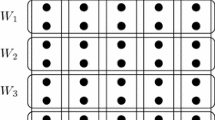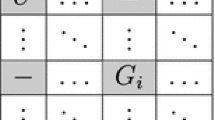Abstract
An equiangular tight frame (ETF) is a type of optimal packing of lines in a real or complex Hilbert space. In the complex case, the existence of an ETF of a given size remains an open problem in many cases. In this paper, we observe that many of the known constructions of ETFs are of one of two types. We further provide a new method for combining a given ETF of one of these two types with an appropriate group divisible design (GDD) in order to produce a larger ETF of the same type. By applying this method to known families of ETFs and GDDs, we obtain several new infinite families of ETFs. The real instances of these ETFs correspond to several new infinite families of strongly regular graphs. Our approach was inspired by a seminal paper of Davis and Jedwab which both unified and generalized McFarland and Spence difference sets. Our main result is a combinatorial analog of their algebraic results.
Similar content being viewed by others
References
Abel R.J.R., Greig M.: BIBDs with small block size. In: Colbourn C.J., Dinitz J.H. (eds.) Handbook of Combinatorial Designs, 2nd edn, pp. 72–79. CRC Press, Boca Raton (2007).
Abel R.J.R., Colbourn C.J., Dinitz J.H.: Mutually orthogonal Latin squares (MOLS). In: Colbourn C.J., Dinitz J.H. (eds.) Handbook of Combinatorial Designs, 2nd edn, pp. 160–193. CRC Press, Boca Raton (2007).
Azarija J., Marc T.: There is no (75,32,10,16) strongly regular graph. arXiv:1509.05933.
Azarija J., Marc T.: There is no (95,40,12,20) strongly regular graph. arXiv:1603.02032.
Bajwa W.U., Calderbank R., Mixon D.G.: Two are better than one: fundamental parameters of frame coherence. Appl. Comput. Harmon. Anal. 33, 58–78 (2012).
Bandeira A.S., Fickus M., Mixon D.G., Wong P.: The road to deterministic matrices with the Restricted Isometry Property. J. Fourier Anal. Appl. 19, 1123–1149 (2013).
Barg A., Glazyrin A., Okoudjou K.A., Yu W.-H.: Finite two-distance tight frames. Linear Algebra Appl. 475, 163–175 (2015).
Bodmann B.G., Elwood H.J.: Complex equiangular Parseval frames and Seidel matrices containing \(p\)th roots of unity. Proc. Am. Math. Soc. 138, 4387–4404 (2010).
Bodmann B.G., Paulsen V.I., Tomforde M.: Equiangular tight frames from complex Seidel matrices containing cube roots of unity. Linear Algebra Appl. 430, 396–417 (2009).
Bracken C., McGuire G., Ward H.: New quasi-symmetric designs constructed using mutually orthogonal Latin squares and Hadamard matrices. Des. Codes Cryptogr. 41, 195–198 (2006).
Brouwer A.E.: Strongly regular graphs. In: Colbourn C.J., Dinitz J.H. (eds.) Handbook of Combinatorial Designs, 2nd edn, pp. 852–868. CRC Press, Boca Raton (2007).
Brouwer A.E.: Parameters of strongly regular graphs. http://www.win.tue.nl/~aeb/graphs/srg/.
Chang K.I.: An existence theory for group divisible designs. Ph.D. Thesis, The Ohio State University (1976).
Chen Y.Q.: On the existence of abelian Hadamard difference sets and a new family of difference sets. Finite Fields Appl. 3, 234–256 (1997).
Corneil D., Mathon R. (eds.): Geometry and Combinatorics: Selected Works of J. J. Seidel. Academic Press, New York (1991).
Coutinho G., Godsil C., Shirazi H., Zhan H.: Equiangular lines and covers of the complete graph. Linear Algebra Appl. 488, 264–283 (2016).
Davis J.A., Jedwab J.: A unifying construction for difference sets. J. Comb. Theory Ser. A 80, 13–78 (1997).
Ding C., Feng T.: A generic construction of complex codebooks meeting the Welch bound. IEEE Trans. Inf. Theory 53, 4245–4250 (2007).
Fickus M., Mixon D.G.: Tables of the existence of equiangular tight frames. arXiv:1504.00253 (2016).
Fickus M., Mixon D.G., Tremain J.C.: Steiner equiangular tight frames. Linear Algebra Appl. 436, 1014–1027 (2012).
Fickus M., Mixon D.G., Jasper J.: Equiangular tight frames from hyperovals. IEEE Trans. Inf. Theory 62, 5225–5236 (2016).
Fickus M., Jasper J., Mixon D.G., Peterson J.D.: Tremain equiangular tight frames. J. Comb. Theory Ser. A 153, 54–66 (2018).
Fickus M., Jasper J., Mixon D.G., Peterson J.D.: Hadamard equiangular tight frames. arXiv:1703.05353.
Fickus M., Jasper J., Mixon D.G., Peterson J.D., Watson C.E.: Equiangular tight frames with centroidal symmetry. Appl. Comput. Harmon. Anal. (to appear).
Fickus M., Jasper J., Mixon D.G., Peterson J.D., Watson C.E.: Polyphase equiangular tight frames and abelian generalized quadrangles. Appl. Comput. Harmon. Anal. (to appear).
Fuchs C.A., Hoang M.C., Stacey B.C.: The SIC question: history and state of play. Axioms 6, 21 (2017).
Ge G.: Group divisible designs. In: Colbourn C.J., Dinitz J.H. (eds.) Handbook of Combinatorial Designs, 2nd edn, pp. 255–260. CRC Press, Boca Raton (2007).
Godsil C.D.: Krein covers of complete graphs. Aust. J. Comb. 6, 245–255 (1992).
Goethals J.M., Seidel J.J.: Strongly regular graphs derived from combinatorial designs. Can. J. Math. 22, 597–614 (1970).
Gordon D.: La Jolla covering repository. https://www.ccrwest.org/diffsets.html.
Grassl M., Scott A.J.: Fibonacci-Lucas SIC-POVMs. J. Math. Phys. 58, 122201 (2017).
Holmes R.B., Paulsen V.I.: Optimal frames for erasures. Linear Algebra Appl. 377, 31–51 (2004).
Iverson J.W., Jasper J., Mixon D.G.: Optimal line packings from nonabelian groups. arXiv:1609.09836.
Jasper J., Mixon D.G., Fickus M.: Kirkman equiangular tight frames and codes. IEEE Trans. Inf. Theory 60, 170–181 (2014).
Jungnickel D., Pott A., Smith K.W.: Difference sets. In: Colbourn C.J., Dinitz J.H. (eds.) Handbook of Combinatorial Designs, 2nd edn, pp. 419–435. CRC Press, Boca Raton (2007).
Lamken E.R., Wilson R.M.: Decompositions of edge-colored complete graphs. J. Comb. Theory Ser. A 89, 149–200 (2000).
Lemmens P.W.H., Seidel J.J.: Equiangular lines. J. Algebra 24, 494–512 (1973).
Mathon R., Rosa A.: \(2-(v, k,\lambda )\) designs of small order. In: Colbourn C.J., Dinitz J.H. (eds.) Handbook of Combinatorial Designs, 2nd edn, pp. 25–58. CRC Press, Boca Raton (2007).
MacNeish H.F.: Euler squares. Ann. Math. 23, 221–227 (1922).
McFarland R.L.: A family of difference sets in non-cyclic groups. J. Comb. Theory Ser. A 15, 1–10 (1973).
McGuire G.: Quasi-symmetric designs and codes meeting the Grey-Rankin bound. J. Comb. Theory Ser. A 78, 280–291 (1997).
Mohácsy H.: The asymptotic existence of group divisible designs of large order with index one. J. Comb. Theory Ser. A 118, 1915–1924 (2011).
Renes J.M.: Equiangular tight frames from Paley tournaments. Linear Algebra Appl. 426, 497–501 (2007).
Renes J.M., Blume-Kohout R., Scott A.J., Caves C.M.: Symmetric informationally complete quantum measurements. J. Math. Phys. 45, 2171–2180 (2004).
Seidel J.J.: A survey of two-graphs. Coll. Int. Teorie Combin., Atti dei Convegni Lincei, vol. 17, pp. 481–511. Accademia Nazionale dei Lincei, Rome (1976).
Spence E.: A family of difference sets. J. Comb. Theory Ser. A 22, 103–106 (1977).
Strohmer T.: A note on equiangular tight frames. Linear Algebra Appl. 429, 326–330 (2008).
Strohmer T., Heath R.W.: Grassmannian frames with applications to coding and communication. Appl. Comput. Harmon. Anal. 14, 257–275 (2003).
Sustik M.A., Tropp J.A., Dhillon I.S., Heath R.W.: On the existence of equiangular tight frames. Linear Algebra Appl. 426, 619–635 (2007).
Szöllősi F.: All complex equiangular tight frames in dimension 3. arXiv:1402.6429.
Tropp J.A.: Complex equiangular tight frames. Proc. SPIE 5914, 591401/1–11 (2005).
Tropp J.A., Dhillon I.S., Heath Jr. R.W., Strohmer T.: Designing structured tight frames via an alternating projection method. IEEE Trans. Inf. Theory 51, 188–209 (2005).
Turyn R.J.: Character sums and difference sets. Pac. J. Math. 15, 319–346 (1965).
van Lint J.H., Seidel J.J.: Equilateral point sets in elliptic geometry. Indag. Math. 28, 335–348 (1966).
Waldron S.: On the construction of equiangular frames from graphs. Linear Algebra Appl. 431, 2228–2242 (2009).
Welch L.R.: Lower bounds on the maximum cross correlation of signals. IEEE Trans. Inf. Theory 20, 397–399 (1974).
Wilson R.M.: An existence theory for pairwise balanced designs I. Composition theorems and morphisms. J. Comb. Theory Ser. A 13, 220–245 (1972).
Xia P., Zhou S., Giannakis G.B.: Achieving the Welch bound with difference sets. IEEE Trans. Inf. Theory 51, 1900–1907 (2005).
Zauner G.: Quantum designs: foundations of a noncommutative design theory. Ph.D. Thesis, University of Vienna (1999).
Acknowledgements
We thank the editors and the three anonymous reviewers for their comments, all of which were helpful. The views expressed in this article are those of the authors and do not reflect the official policy or position of the United States Air Force, Department of Defense, or the United States Government. This work was partially supported by the Summer Faculty Fellowship Program of the United States Air Force Research Laboratory.
Author information
Authors and Affiliations
Corresponding author
Additional information
Communicated by J. Jedwab.
Publisher's Note
Springer Nature remains neutral with regard to jurisdictional claims in published maps and institutional affiliations.
Rights and permissions
About this article
Cite this article
Fickus, M., Jasper, J. Equiangular tight frames from group divisible designs. Des. Codes Cryptogr. 87, 1673–1697 (2019). https://doi.org/10.1007/s10623-018-0569-z
Received:
Revised:
Accepted:
Published:
Issue Date:
DOI: https://doi.org/10.1007/s10623-018-0569-z




